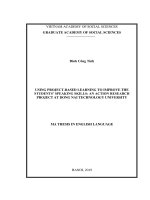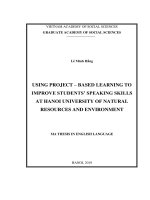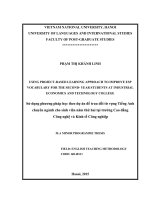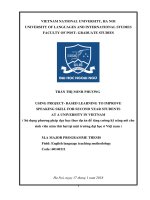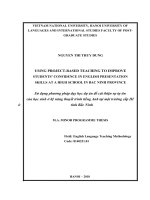Using project based learning to improve 8th graders’ english speaking skill
Bạn đang xem bản rút gọn của tài liệu. Xem và tải ngay bản đầy đủ của tài liệu tại đây (1.02 MB, 86 trang )
Ministry of education and training
Vinh university
NguyỄn ThỊ HiỀn
USING PROJECT-BASED LEARNING
TO IMPROVE 8TH GRADERS’ ENGLISH SPEAKING SKILL
MASTER’S THESIS IN EDUCATION
Nghệ An, 2019
Ministry of education and training
Vinh university
NguyỄn ThỊ HiỀn
USING PROJECT-BASED LEARNING
TO IMPROVE 8TH GRADERS’ ENGLISH SPEAKING SKILL
Major: Theory and Methodology of English Language Teaching
Code: 8.14.01.11
MASTER’S THESIS IN EDUCATION
Supervisor : Huỳnh Anh Tuấn, Ph.D
Nghệ An, 2019
STATEMENT OF AUTHORSHIP
I hereby acknowledge that this study entitled “Using Project- based
Learning to improve 8th graders’ English speaking skill” is my own work.
The data and findings discussed in the thesis are true, used with permission, and
have not been published elsewhere.
Author
Nguyen Thi Hien
i
ABSTRACT
This research was conducted to grade - 8 students at a secondary school
in Nghe An in the Academic Year of 2018/2019. This study aimed to find out
whether Project-Based Learning could improve students’ speaking skill or not
and what speaking aspects were improved through PBL. Besides this, we can
find out the strengths and weaknesses of the use of PBL in improving students’
speaking skill.
The action research was conducted in two cycles. Each cycle consisted
of four meetings. The research procedures were divided into four stages:
planning, acting, observing, and reflecting. In collecting the data, the writer used
observation, field notes, questionnaire, and test.
The result of the research indicated that Project-Based Learning could
improve the students’ speaking skill which consisted of vocabulary,
pronunciation, grammar, fluency, and comprehension aspects; The progress was
showed by the increases in the scores achieved in the tests from the pre-test to
the cycle 1 post-test and then the final cycle 2 post-test.
The strengths of Project-Based Learning implementation in teaching
speaking could be also shown as follows: Project-Based Learning increased the
students’ interest and motivation in following the classroom activities, and the
students’ positive responses were also indicated by the students’ good
interaction and collaboration in a group work. Meanwhile the weaknesses of
PBL implementation are: some students still did not take part or were not really
active like the others and they depended on the teachers in doing project.
Based on the result of the study, the researcher concluded that PBL is an
appropriate and effective teaching – learning technique which can be applied in
improving students’ speaking skills.
ii
ACKNOWLEDGEMENTS
Firstly, I am sincerely grateful to my supervisor, Dr. Huynh Anh Tuan,
who directly gave me precious advice and valuable guidance that help me to
carry out the study. Without his help, I could not have finished the thesis.
I also wish to express my gratitude to my friends and colleagues due to
their constructive comments and criticisms. Besides, I would like to thank the
students of class 8A at the Secondary School where the study was carried out for
their active participation in my study.
Additionally, I am in debt of the author of the books and studies that are
relevant to my study, I have read their ideas for reference, writing Literature
Review and applying them creatively.
Lastly but not least, I wish to express my special thanks to my husband
and all the members of my family, who always give me their love, care, support
and encouragement.
iii
LIST OF ABBREVIATIONS
PBL:
Project-based Learning
CAR:
Classroom Action Research
CLT:
Communicative Language Teaching
EFL:
English as a foreign Language
GTM:
Grammar Translation Method
iv
TABLE OF CONTENTS
STATEMENT OF AUTHORSHIP........................................................................ i
ABSTRACT .......................................................................................................... ii
ACKNOWLEDGEMENTS ................................................................................. iii
LIST OF ABBREVIATIONS .............................................................................. iv
TABLE OF CONTENTS ...................................................................................... v
LIST OF TABLES .............................................................................................. vii
LIST OF CHARTS............................................................................................. viii
CHAPTER 1: INTRODUCTION ......................................................................... 1
1.1. Rationale......................................................................................................... 1
1.2. Aims and Objectives ...................................................................................... 2
1.2.1. Aims of the study ........................................................................................ 2
1.2.2. Objectives of the study ................................................................................ 2
1.3. Research questions ......................................................................................... 2
1.4. Research methods ........................................................................................... 3
1.5. Scope of the study .......................................................................................... 3
1.6. Significance of the study ................................................................................ 3
1.7. Structure of the thesis ..................................................................................... 3
CHAPTER 2: LITERATURE REVIEW .............................................................. 5
2.1. Speaking ......................................................................................................... 5
2.1.1 Definition of Speaking ................................................................................. 5
2.1.2. Aspects of speaking skills ........................................................................... 6
2.1.3. Speaking problems ...................................................................................... 8
2.1.4. Assessing speaking skill .............................................................................. 8
2.2. Project- based learning (PBL) ...................................................................... 14
2.2.1. Definitions of PBL .................................................................................... 14
2.2.2. Characteristics of PBL .............................................................................. 16
v
2.2.3. Benefits of PBL in teaching English as a foreign language...................... 16
2.2.4. Challenges of PBL in English classroom .................................................. 17
2.2.5. Stages in project work ............................................................................... 18
2.2.6. Applying PBL in improving speaking skill .............................................. 19
2.3. Related previous studies ............................................................................... 20
CHAPTER 3: METHODOLOGY ...................................................................... 22
3.1. Context of the study ..................................................................................... 22
3.2. Research approach........................................................................................ 24
3.3. Research method .......................................................................................... 26
3.4. Data collection instruments .......................................................................... 26
3.5. Data collection procedures ........................................................................... 28
3.6. The projects in Tieng Anh 8 ......................................................................... 28
3.7. Data analytical framework ........................................................................... 29
CHAPTER 4: FINDINGS AND DISCUSSIONS .............................................. 33
4.1. The improvement of the students’ speaking skill ........................................ 33
4.2. The attitudes of the students toward the application of PBL in improving
their speaking skill. ............................................................................................. 41
4.3. The challenges that teacher can encounter when applying PBL in improving
secondary school students’ speaking skill........................................................... 49
CHAPTER 5: CONCLUSION ............................................................................ 51
5.1. Recapitulation of the research ...................................................................... 51
5.2. Implications .................................................................................................. 52
5.3. Limitations.................................................................................................... 53
5.4. Suggestions for further research................................................................... 53
REFERENCES .................................................................................................... 55
Appendix ............................................................................................................. 58
vi
LIST OF TABLES
Table 3.1. The Criteria of Speaking Aspects ...................................................... 30
Table 3.2. The increase of the Student Number in Speaking Aspect Criteria .... 31
Table 4.1. The Criteria of Speaking Aspects ...................................................... 35
Table 4.2. The increase of the Student Number in Speaking Aspect Criteria .... 35
Table 4.3: The students’ Pre-Speaking Test Result ............................................ 37
Table 4.4: The students’ Post-Speaking Test Result in cycle 1 .......................... 38
Table 4.5: The students’ Post-Speaking Test Result in cycle 2 .......................... 39
Table 4.6: Students’ motivation of learning English Speaking Skill .................. 42
Table 4.7: The factors affect Students’ Speaking Abilities ................................ 43
Table 4.8: Students’ attitude toward speaking lesson using PBL ....................... 45
Table 4.9: Students’ Interest in Types of Speaking Activities............................ 46
Table 4.10: Students’ motivation in taking part in projects ................................ 47
vii
LIST OF CHARTS
Chart 4.1: Students’ Speaking Mean Score in each cycle .................................... 40
Chart 4.2: Students’ opinion about the most difficult skill ................................... 41
Chart 4.3: Students’ opinion for the frequency of speaking English .................... 43
Chart 4.4. Teachers’ attitude about students’ mistakes ......................................... 44
Chart 4.5: Students’ Participation in projects ....................................................... 46
Chart 4.6: The effectiveness of the use of PBL .................................................... 48
viii
CHAPTER 1: INTRODUCTION
This chapter presents a general outline of the study, which includes the
rationale, the aims and objectives, research questions, research methods, scope,
significance of the study and structure of the thesis.
1.1. Rationale
Nowadays, English has become an international language and a
compulsory subject at schools in Viet Nam. Especially, since Viet Nam became
an official member of WTO in 2007, the importance of English cannot be
denied. English is regarded as a means of communication in all fields and it
makes countries in the world closer. Therefore, the quality of teaching and
learning English has been viewed as one of the most important aims for
educators in Viet Nam.
Since the goal of studying English is to develop communicative
competence, of the four language skills, speaking is considered as the most
essential one. However, most students remain weak in their oral ability. They
can easily read and write English but find it hard to communicate in real- life
conversations. As a general fact, at my school, a great number of students still
encounter difficulties in speaking activities. Especially, in responding to oral
questions, the students feel shy to express their ideas. A question is raised
concerning the factors preventing students from improving in their speaking. It
can be caused by their lack of vocabulary, grammar and the problem of
pronunciation as well. They are afraid to make mistakes and are not confident
enough to present in front of the class.
Related to the problems above, the teachers should choose and apply
appropriate techniques in teaching. And the author finds that Project – based
learning (PBL) is recommended as an effective way to help students overcome
problems and gain their improvement in speaking. PBL requires the students to
1
design, plan and carry out projects that produces their products. Project work
encourages students to think critically and motivates them to transfer language 1
knowledge and skills acquired from the classroom to their real world. Products
that students gain from the practice activities may be one video clip performed
by students in English. It can also be a project presented in class by students
with the teacher’s guidance. This approach motivates students’ interest and their
creativity in learning speaking skill.
Based on the explanation and all the reasons above, the author decided to
conduct a study on: “Using Project- based Learning to improve 8th graders’
English speaking skill”.
1.2. Aims and Objectives
1.2.1. Aims of the study
The study aims to:
- Improve the speaking skill of the students at a secondary school
- Investigate the influences of PBL on students’ speaking skill (fluency,
accuracy, …)
1.2.2. Objectives of the study
+ To find out whether the application of PBL has any significant impact
on the improvement of the students’ speaking performance.
+ To investigate the challenges that teachers can encounter when applying
PBL in teaching speaking skill to secondary school students
+ To investigate the students’ attitudes towards the application of PBL in
teaching speaking skill
1.3. Research questions
In order to achieve the aims mentioned above, the study seeks the answers
to the following questions:
1. To what extent does the use of Project- based Learning help to
improve
2
the students‟ speaking skill?
2. What are the students‟ attitudes towards the application of Projectbased Learning in improving their speaking skill?
3. What challenges can the teacher encounter when applying PBL in
improving secondary school students‟ speaking skill?
1.4. Research methods
With the aim of investigating the effects of PBL on English speaking
skills for language learners, an action research project was carried out. The data
collection instruments used include: projects designed for the intervention,
speaking tests, survey questionnaires, and field notes and observations. 40
students of a secondary school in Nghi Loc district, Nghe An were involved in
this study.
1.5. Scope of the study
The study focuses specifically on using Project- based learning in
improving their speaking skill to the 8th graders in five aspects, namely
comprehension, vocabulary, grammar, fluency and pronunciation. 40 students in
the same class participated in the study
1.6. Significance of the study
In accordance with the aims, the study can be used as a reference for the
researchers who will concentrate on improving students’ speaking skill. The
author hopes that PBL can be applied effectively by the teachers during the
process of teaching and learning English speaking.
1.7. Structure of the thesis
This research comprises five chapters as follow:
Chapter 1: Introduction – In this chapter, the rationale of the problem
dealing with the topic, the aims of the study, the research questions and the
scope of the study, the research methods, significance of the study, and the
structure of the thesis
3
Chapter 2: Literature review – The relevant literature on speaking skills,
Project-based language teaching and learning and some related previous
studies reviewed in this chapter.
Chapter 3: Methodology – The third chapter introduces research
methodology of the study. It explains the materials, participants, instruments for
data collection, research procedures and data analysis procedures.
Chapter 4: Findings and Discussions – This chapter presents the results
and discussions developed after the impacts analyzed.
Chapter 5: Conclusion – This fifth chapter covers the conclusion,
implications, limitations of the study and some suggestions for further
researches. Following these chapters are the references and appendices.
4
CHAPTER 2: LITERATURE REVIEW
This study investigates the effectiveness of PBL on the improvement
of secondary school students’ speaking skills. An action research project was
conducted to examine whether the implementation of PBL in one speaking
classroom at a secondary school, in Nghi Loc district, Nghe An province in the
academic year of 2018-2019 improved students’ speaking competence.
This chapter presents background information on teaching and learning
speaking skills in historical perspective to its current place in PBL. This is
followed by a more detailed discussion of PBL, its goals, projects and
characteristics of projects, and the instructional components of PBL. The
projects used for the purpose of this study were designed in the context of
project descriptions in the literature. The advantages and drawbacks of PBL are
also pointed out.
2.1. Speaking
2.1.1 Definition of Speaking
“Speaking is an interactive process of constructing meaning that involves
producing, receiving and processing information”. (Brown, 1994 and Burns &
Joyce, 1997). Speaking enables students to send and receive information through
conversation.
As for the importance of speaking, Ur, (1991) points out that: “of all four
language skills, speaking seems the most important. Obviously, if students want
to develop the language competence, they need to use a foreign language
effectively in situations they encounter outside the classroom and have to
experience how language is used as a tool for communication inside the class”.
The purpose of real communication is to accomplish a task, such as
conveying a telephone message, obtaining information, or expressing an
opinion. Giving an uninterrupted oral presentation is quite different from
5
communicating with other speakers for specific purposes. Nunan (1998)
suggests that speakers should start with the smallest unit of language, namely,
individual sounds, and move through mastery of words and sentences to
discourse.
In general, speaking is regarded as one of the prime skills to be
mastered. With the increasing attention on the acquisition of language skills,
especially speaking, it is very important to find and implement techniques and
methods which significantly can help learners to develop this skill. The mastery
of speaking skills is a priority for the foreign language learners. Learners
often evaluate their success in language learning of English on the basis how
well their improvement on speaking the language.
2.1.2. Aspects of speaking skills
2.1.2.1. Conversational discourse
Brown (2001) asserts that “the goals and the procedures for
teaching conversation are extremely diverse, depending on the students, teacher,
and overall context of the class”. Recent pedagogical research on teaching
conversation has provided some parameters developing objectives and
techniques.
2.1.2.2. Pronunciation
“The
majority
of
learners
will
never
acquire
an
accent-free
command of a foreign language. Therefore, the language programs should
emphasize the whole language, meaningful contexts, and automaticity of
production should focus on these phonological details of language” (Nguyen
and Tran, 2015).
2.1.2.3. Accuracy and fluency
Accuracy is the ability to speak correctly without making serious mistakes
and therefore the teacher's correction in speaking activities is very necessary.
6
Fluency is the ability to speak confidently without irrelevant pauses
or hesitation, If the teacher concentrate on students´ mistakes and devote time
to their correction, their fluency may be reduced
2.1.2.4. Affective factors
One of the major obstacles that learners have to overcome in learning
speaking skills is the anxiety of the things that are wrong or incomprehensible.
Because of the language ego that informs people that "you are what
you
speak," learners are reluctant to be judged by listeners. This affects to the
success in second language acquisition due to their lack of motivation and selfconfidence.
2.1.2.5. The interaction effect
Conversations are collaborative, which presents a further complication in
interactive discourse. The interlocutor effect or the difficulty of a speaking task
is measured by the skills of one's interlocutor. In other words, one learners’
performance is always colored by that person he or she is talking to. In fact,
every speaker plays the role of both a listener and a speaker. Therefore,
one is certainly unable to respond if he/ she cannot understand what is said.
2.1.2.6. Performance conditions
Speaking performance can be affected by performance conditions. There
are four types of performance conditions including time pressure, planning, the
standard of performance and the amount of support.
2.1.2.7. Topical knowledge
Topical knowledge is the speaker’s knowledge of relevant topical
information. If learners are provided the knowledge of the topic, they will be
able to use a language with reference to the world in which they live. According
to Bachman & Palmer (1996, cited in Nguyen and Tran), “Topical knowledge
is defined as knowledge structures in long - term memory and it affects
speaking skills”.
7
2.1.3. Speaking problems
Most of the students have their own problems which prevent them from
communicating verbally. The problems students of foreign language may
encounter during the process of learning speaking skills are presented as below:
* Inhibition: This means that when learners have to talk about something
in a target language, they are often inhibited. They are worried about making
mistakes and fearful of criticism. They feel shy of the other students’ attention
towards themselves.
* Nothing to say: Some learners complain that they cannot think of
anything to say and they do not have any motivation to express themselves.
Probably it is because their teachers choose a topic that is not appropriate for
them or they do have enough information about it
* Low or uneven participation: In a class with a large number of students,
each student often have very little time for talking because just one student talks
at a time and the other students try to hear him/her. Besides, some learners
dominate the whole class while others talk very little or never speak. They use it
because it is very easy
* The use of mother-tongue: In the speaking class, some learners share the
same mother-tongue, especially when they explain something to their partners.
They often use it because it is very easy to understand.
2.1.4. Assessing speaking skill
2.1.4.1. How to assess speaking skill
Assessing speaking skills is probably one of the biggest challenges
compared to the three language skills because you have to pay attention to
aspects such as:
Fluency:
This means speaking easily, reasonably quickly and without
having to stop and pause a lot.
Pronunciation: The result of producing the sounds of speech, including stress,
8
articulation and intonation.
Vocabulary:
The words used in a language.
Accuracy:
The correction in Learners’ use of the language system
including grammar, pronunciation and vocabulary
Interaction:
The ability to interact with others during communicative tasks.
Communication: The students’ ability to transmit their ideas.
2.1.4. 2. Basic Types of Speaking Assessment Tasks
a. Imitative
Imitative speaking tasks are based on repetition. You just need to repeat
a sentence you hear and focus on pronunciation.
Test maker considers using this type of assessment if he is not interested
in test taker’s competence in understanding and conveying meaning or in getting
involved in interactive conversation. The competence assessed is that of purely
phonetic, prosodic, lexical and grammatical (pronunciation).
b. Intensive
* Reading Aloud
A check on stress-pattern, rhythm and pronunciation alone may be
conducted using reading aloud. We use reading aloud as a companion for other
more communicative tasks.
* Directed Response Task
DRT is beneficial to elicit a specific grammatical form or a
transformation of a sentence which requires minimal processing
* Sentence/Dialogue Completion
The responsive-type of sentence/dialogue completion may actually be
free to say and keep us from the risk of judging a test taker’s competence as
insufficient caused by aural misunderstanding in processing the input. SDC
helps measure speaking competence apart from its interrelatedness to listening.
* Translation
9
It is believed that because speaking is negotiation of intended
meaning, interpreting-game can be used to measure test-taker competence in
conveying his message into the target language.
* Limited picture-cued Task
Pictures are convenient to elicit description.
c. Responsive
Small dialogue, response to spoken prompt (simple greeting, request &
comments)
* Question and Answer
Referential question requires test takers to produce meaningful
language in response. Such questions may require an open-ended response or a
counter-question directed to the interviewer.
* Giving Instruction and Direction
In this type of task, test takers are elicited their performance in
describing a how-to description. A five- to six-sentence response may be
sufficient to be required either from an impromptu question or a-minute
planning prior to the instruction.
* Paraphrasing
Oral Paraphrasing should be conducted with caution because test
taker’s competence may be mistakenly judged by their short-term memory and
listening comprehension instead of their speaking production.
d. Interactive (larger dialogue on Transactional and Interactional Conversation)
* Interview
Interview can be face-to-face, one-on-one or two-on-one each with its
advantage and disadvantage. A two-on-one interview may save time and
scheduling and provide authentic interaction between two test takers, although it
pose a risk of one test taker domination the other.
Hughes (1989:105) proposes 11 rules to conduct an interview:
10
1) Make the oral test as long as feasible
2) Include as wide a sample of specified content as is possible in the time
available 3) Plan the test carefully
4) Give the candidate as many „fresh start‟ as possible
5) Select interviewers carefully and train them
6) Use a second tester
7) Set only a tasks and topics that would be expected to cause candidates no
difficulty in their own language
8) Carry out the interview in a quiet room with good acoustics
9) Put candidates at their ease
10) Collect enough relevant information
11) Do not talk to much (the interviewer)
In addition to Hughes’ proposal, Canale (1984) proposes four main steps to
follow to conduct, in this case, an oral proficiency test.
1) Warm Up : small talk about identity, origin and the like
2) Level-Check : wh-questions, narrative without interruption, read a passage
aloud, tells how to make or do something, a brief guided role play
3) Probe : field-related questions
4) Wind-down : easier questions pertaining test taker’s feeling about the
interview
*Drama-like Task
Drama-like task is divided into three sub-types: improvisations, role
play and simulation. The difference of each is respectively the preparation and
scripting. Improvisation gives very little opportunity for test taker to prepare the
situation and may incite creativity in using the language. Role play provides
slightly longer time to and test taker can prepare what to say although scripting
is highly unlikely. Meanwhile, simulation requires planning and decision
11
making. Simulation may involve real-world socio drama which is the pinnacle
of speaking competence.
Like interview, drama-like task may evoke unpredictable response.
Similar care used to tackle interview may be useful for this type of task as well.
* Discussions and Conversations
Discussions and Conversations (Brown, 2004: 175) provide somewhat
similar difficulties in terms of predictability of the response hence consistency
of the scoring to that of interview and drama-like tasks. Test makers seem to
choose this type of task as informal assessment to elicit and observe test taker’s
performance.
* Games
Games can be used as informal assessment for speaking. Some examples
of games such as crossword puzzle, information gap, predetermined direction
map. An information gap activity involves collecting complete information to
restructure a building, sequence a picture into order or simply find the
differences between two pictures. To score an information gap activity, the test
maker can consider the speaker’s “accuracy and clarity of the description as well
as on the reconstruction.
e. Extensive (monologue)
* Oral Presentation
It is commonly practiced to present a report, paper or design in school
setting. An oral presentation can be used to assess a speaking skill holistically or
analytically.
* Picture-cued Story Telling
Using a picture or a series of pictures is to make it into a stimulus for
longer story or description; a six-picture sequence with enough details in the
settings and character will be sufficient to test, among others, vocabulary, time
relatives, past tense irregular verbs and even fluency in general.
12
*Retelling a Story, News Event
Different from paraphrasing, retelling a story takes longer stretch of
discourse with different, preferably narrative, genre. The focus is usually on
meaningfulness of the relationship of events within the story, fluency and
interaction to audience.
*Translation
In this type of task, a longer text preferably in written form which is
presented in the test taker’s native language is to be studied prior to interpreting
the text with ease in the actual testing. The text can cover a dialogue, procedure,
complex directions, synopsis or a play script.
3. Scoring Rubric
An effective assessment should follow this rule: (1) Specific criteria, (2)
Appropriate task, (3) Elicitation of optimal output,(4) Practical and reliable
scoring procedures
Scoring remains the major challenge in assessment. There are at least two
types of known scoring rubric for speaking: (1) holistic and (2) analytical.
A holistic rubric range, for example, from 1 to 6 each reflecting unique
capacity of the speaker with 6 being normally native-like traits and 1 a total
misuse of language which incite misunderstanding.
An analytical rubric, on the other hand, scores performance in different
aspects such as grammar, vocabulary, comprehension, fluency, pronunciation
and task completion. There are two common practices: (1) the total score is
summed in average to reflect an overall score or (2) each category is given a
different weight sometimes without the necessity to sum up the total score.
O’Malley (1996:65) suggests several steps in developing rubric:
(1) Set criteria of task success
(2) Set dimensions of language to be assessed (grammar, vocabulary,
Fluency, pronunciation, etc)
13
(3) Give appropriate weight to each dimension (if omission is possible,
do)
(4) Focus of what test taker can do, instead of what they cannot.
In conclusion, the key of assessing speaking skill is understood as the
continuum of (1) spoken language, (2) task types and (3) scoring rubric. This
non-rigid separation between one level of competence and another requires time
and effort in specifying the criteria of speaking, task to elicit particular behavior
and in developing practical yet representative scoring rubric. The variety of task
types will help test maker to decide which one is appropriate for this particular
skill.
Based on those theories, the researcher used some indicators of speaking
skill.
They were
comprehension,
vocabulary,
grammar,
fluency and
pronunciation. It was listed below:
Comprehend the material to express or respond the question correctly.
Use appreciate vocabulary to express ideas
Use correct grammar to make well- formed utterances
Make correct dialogue or speech fluently
Perform acceptable pronunciation to express comprehensible utterance
As for speaking assessments, they are conducted three times (Pre- test,
Post – test 1 and Post - test 2) to see the process of improvement of the students’
speaking skill from the first cycle to the following ones. The speaking
assessment sheet used contains five aspects as I have mentioned. Each aspect
has its own criteria scaled from1-5.
2.2. Project- based learning (PBL)
2.2.1. Definitions of PBL
There are many definitions of Project-based learning offered by various
authors. Moss and Van Duzer define it as an instructional approach that
contextualizes learning by presenting learners with problems to solve or
14
products to develop. As discussed in, project-based learning (PBL) is a model
that organizes learning around projects which are complex tasks, based on
challenging questions or problems encountered by students, conducted in certain
periods of time and culminated in realistic products that might be in form of
presentation, exhibition, publication, etc. (Thomas, 2000).
According to Blank (as cited on Railsback, 2002) stated that Project –
based learning is an authentic instructional model or strategy in which students
plan, implement, and evaluate projects that have real world applications beyond
the classroom, Project – Based learning has its roots in constructivism approach
since in this learning, students play an active role to design their own learning.
The project is supposed to be long-term, requires teamwork among
students, and results in a final product. It means not every task can be considered
as project. According to Patton (2012), in PBL, students are the ones designing
the project and planning what need to do to carry it out. From those statements,
it can be inferred that PBL is a method in which the students are learning
through a project that is decided by themselves with the help from teachers so
that they can actively engaged in the learning process.
In the PBL technique, the students sit together, face one another, and talk
freely about the problem. They sit in a circle discussing the problem which
needs to be solved. This situation creates free communication in which the
students can use the language freely in the classroom without feeling shy.
Project based learning is a dynamic approach to teaching in which
students explore real-world problems, issues and challenges, are inspired to
obtain a deeper knowledge of the subjects they are studying. Moreover, the
students can develop confidence and self-direction when they work in groups.
The purpose of PBL is to foster students’ abilities for lifelong learning
through contextualizing learning with solving problems. When doing so,
15

